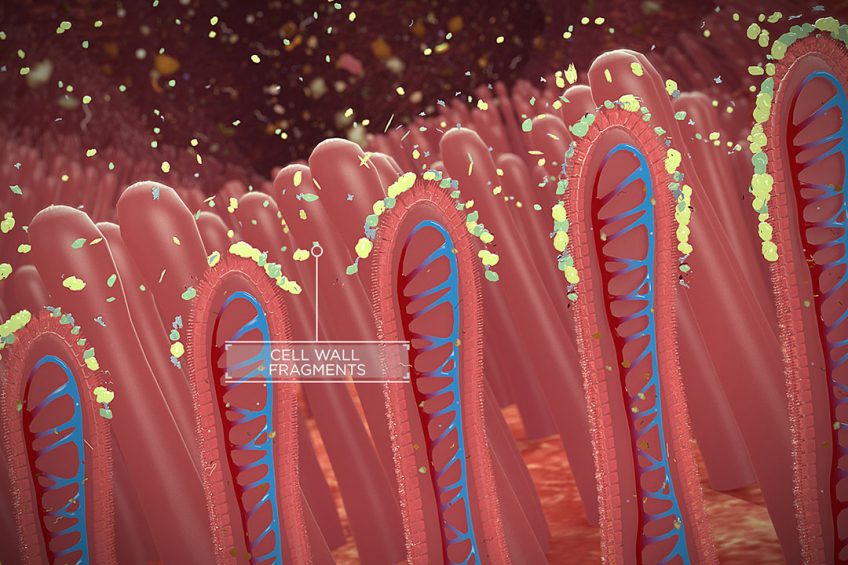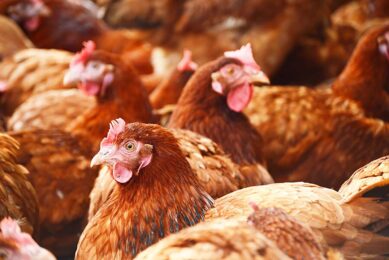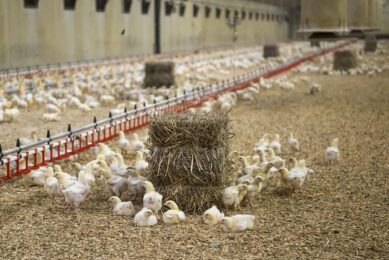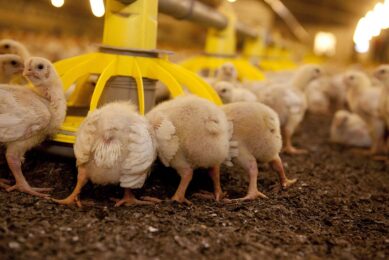Targeting peptidoglycans for improved feed efficiency

Growing birds efficiently and sustainably, that is the biggest challenge of any poultry operation. Utilising all available nutrients in the feed is key. Timely catalysis of peptidoglycan could help to avoid a ‘build up’ of bacterial cell debris in the poultry gut, maintaining normal gastrointestinal function and effective nutrient digestion and absorption.
The cost of feed generally represents between 60-70% of the total costs associated with animal production. As such, the global feed industry is always looking for new and innovative ways to improve feed efficiency for feed-cost optimisation. One important factor to consider when trying to achieve optimum feed utilisation is how effectively the animal absorbs nutrients from their diet. Poultry farmers recognise that optimising gut function can achieve better nutrient utilisation and improved feed efficiency as the digestion and absorption of dietary compounds is more effective. Here, gut bacteria components, specifically peptidoglycan (PGN), can play a significant role as PGN waste can affect gut health and the efficient conversion of feed into its constituent parts for optimal nutrient absorption as well as poultry production and welfare.
Effect of microbiota on gut health
Gastrointestinal function is influenced by many factors including a tailored diet, animal welfare and immune status as well as the structural and functional integrity of the gastrointestinal barrier. More recently, researchers have been interested in the effect gut microbiota, and their interaction with the host, have on normal gut function and subsequent feed efficiency. The intestinal microbiota is essential to the normal regulation of the host homeostasis as they contribute to several physiological functions including digestion and absorption, energy metabolism, prevention of mucosal infection and modulation of the immune system. These interactions emphasise the significant role gut microbiota have in maintaining the health and well-being of poultry.
However, while the effect of living microbiota on gastrointestinal functionality has been thoroughly researched and understood, the effect of dead bacterial biomass on gut health and nutrient absorption is largely overlooked in research; until now.
Targeting PGN specifically
PGN, also referred to as murein, is a heteropolymer composed of polysaccharide chains which are cross-linked through short peptides. Unique to both gram-positive and gram-negative bacterial cell walls, PGN provides structural support (against osmotic pressures for instance) to the bacteria. Gram-positive and gram-negative intestinal bacteria do not cause disease normally, however, fragments of their cell walls, which are mostly made up of PGN, may constrain feed efficiency and poultry performance by hindering gut functionality and lowering intestinal effectiveness.
Furthermore, it is well known that normal bacterial cell division and natural cell death, release cell wall fragments, hence an abundant source of PGN into the gastrointestinal tract where it can interact with the surface of the gut wall (Figure 1). This can cause PGN to accumulate in the gut where it becomes intestinal waste, also known as ‘debris’, and interferes with the gastrointestinal tract’s capacity to absorb nutrients into the bloodstream, reducing digestibility of nutrients and impairing feed efficiency. It has also been suggested that PGN may cause an increase in intestinal permeability and a decrease in gastrointestinal motility, which can compromise nutrient digestion and absorption further and adversely affect animal performance.

A novel nutritional solution
Timely catalysis of PGN could help to avoid a ‘build up’ of bacterial cell debris in poultry gut, maintaining normal gastrointestinal function and effective nutrient digestion and absorption. Dietary supplement solutions that could enhance the normal active gut microbiota, for example, is an attractive tool that may prevent intestinal issues and promote feed efficiency and animal performance. However, for nutrition interventions to be successful, they need to help maintain the balance between the host and gastrointestinal microbiota and prevent disturbance of the gut structure.
Balancius, a novel microbial muramidase from DSM, targets PGN in dead bacteria in the gut by catalysing its degradation in bacterial cell wall fragments without affecting live bacterial populations . By hydrolysing PGNs in bacterial cell wall fragments, Balancius improves gut functionality by removing excessive bacterial debris and preventing PGN from adversely affecting nutrient digestion and absorption. For example, several studies found that the addition of Balancius to broiler diets significantly improved the feed conversion ratio (FCR) by 4-6 points (3%), compared to broilers that were not fed with it. As such, farmers can observe an improvement in feed-cost efficiency and poultry performance.
Conclusion
Supporting the digestion of PGN from dead bacteria in the gastrointestinal tract of broiler chickens is key to maintaining the balance of good gut functionality and ensuring good feed efficiency and animal performance and health. As the first and only microbial muramidase to work in the digestive track, Balancius represents an exciting nutritional solution that poultry farmers can use to unlock the hidden potential in gastrointestinal functionality and significantly improve feed efficiency which translates into significant savings for animal producers. By utilising Balancius in feed, farmers can also contribute to significant improvements in sustainability. Including it in the feed to produce one million broilers for instance, could mean 125,000kg less feed needed to grow the same quantity of broiler meat. Furthermore, if Balancius was used in all broiler diets in Latin America and North America, it is estimated to save about 4.2 million tonnes of greenhouse gas emissions.
Join 31,000+ subscribers
Subscribe to our newsletter to stay updated about all the need-to-know content in the poultry sector, three times a week. Beheer
Beheer








 WP Admin
WP Admin  Bewerk bericht
Bewerk bericht